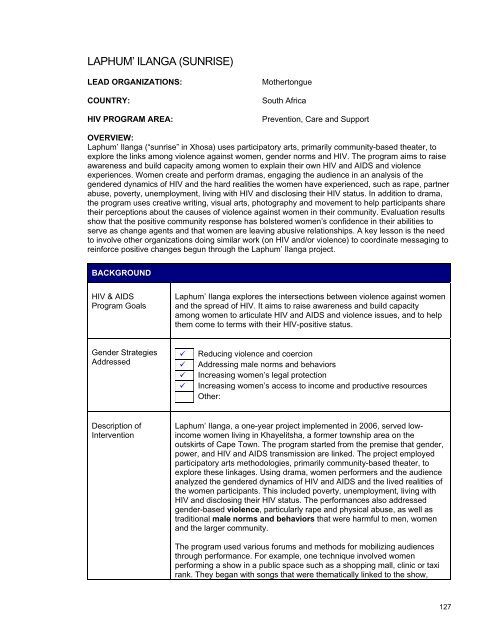Implementing Multiple Gender Strategies to Improve HIV and ... - ICRW
Implementing Multiple Gender Strategies to Improve HIV and ... - ICRW
Implementing Multiple Gender Strategies to Improve HIV and ... - ICRW
Create successful ePaper yourself
Turn your PDF publications into a flip-book with our unique Google optimized e-Paper software.
LAPHUM’ ILANGA (SUNRISE)<br />
LEAD ORGANIZATIONS:<br />
COUNTRY:<br />
<strong>HIV</strong> PROGRAM AREA:<br />
Mother<strong>to</strong>ngue<br />
South Africa<br />
Prevention, Care <strong>and</strong> Support<br />
OVERVIEW:<br />
Laphum’ Ilanga (“sunrise” in Xhosa) uses participa<strong>to</strong>ry arts, primarily community-based theater, <strong>to</strong><br />
explore the links among violence against women, gender norms <strong>and</strong> <strong>HIV</strong>. The program aims <strong>to</strong> raise<br />
awareness <strong>and</strong> build capacity among women <strong>to</strong> explain their own <strong>HIV</strong> <strong>and</strong> AIDS <strong>and</strong> violence<br />
experiences. Women create <strong>and</strong> perform dramas, engaging the audience in an analysis of the<br />
gendered dynamics of <strong>HIV</strong> <strong>and</strong> the hard realities the women have experienced, such as rape, partner<br />
abuse, poverty, unemployment, living with <strong>HIV</strong> <strong>and</strong> disclosing their <strong>HIV</strong> status. In addition <strong>to</strong> drama,<br />
the program uses creative writing, visual arts, pho<strong>to</strong>graphy <strong>and</strong> movement <strong>to</strong> help participants share<br />
their perceptions about the causes of violence against women in their community. Evaluation results<br />
show that the positive community response has bolstered women’s confidence in their abilities <strong>to</strong><br />
serve as change agents <strong>and</strong> that women are leaving abusive relationships. A key lesson is the need<br />
<strong>to</strong> involve other organizations doing similar work (on <strong>HIV</strong> <strong>and</strong>/or violence) <strong>to</strong> coordinate messaging <strong>to</strong><br />
reinforce positive changes begun through the Laphum’ Ilanga project.<br />
BACKGROUND<br />
<strong>HIV</strong> & AIDS<br />
Program Goals<br />
Laphum’ Ilanga explores the intersections between violence against women<br />
<strong>and</strong> the spread of <strong>HIV</strong>. It aims <strong>to</strong> raise awareness <strong>and</strong> build capacity<br />
among women <strong>to</strong> articulate <strong>HIV</strong> <strong>and</strong> AIDS <strong>and</strong> violence issues, <strong>and</strong> <strong>to</strong> help<br />
them come <strong>to</strong> terms with their <strong>HIV</strong>-positive status.<br />
<strong>Gender</strong> <strong>Strategies</strong><br />
Addressed<br />
<br />
<br />
<br />
<br />
Reducing violence <strong>and</strong> coercion<br />
Addressing male norms <strong>and</strong> behaviors<br />
Increasing women’s legal protection<br />
Increasing women’s access <strong>to</strong> income <strong>and</strong> productive resources<br />
Other:<br />
Description of<br />
Intervention<br />
Laphum’ Ilanga, a one-year project implemented in 2006, served lowincome<br />
women living in Khayelitsha, a former <strong>to</strong>wnship area on the<br />
outskirts of Cape Town. The program started from the premise that gender,<br />
power, <strong>and</strong> <strong>HIV</strong> <strong>and</strong> AIDS transmission are linked. The project employed<br />
participa<strong>to</strong>ry arts methodologies, primarily community-based theater, <strong>to</strong><br />
explore these linkages. Using drama, women performers <strong>and</strong> the audience<br />
analyzed the gendered dynamics of <strong>HIV</strong> <strong>and</strong> AIDS <strong>and</strong> the lived realities of<br />
the women participants. This included poverty, unemployment, living with<br />
<strong>HIV</strong> <strong>and</strong> disclosing their <strong>HIV</strong> status. The performances also addressed<br />
gender-based violence, particularly rape <strong>and</strong> physical abuse, as well as<br />
traditional male norms <strong>and</strong> behaviors that were harmful <strong>to</strong> men, women<br />
<strong>and</strong> the larger community.<br />
The program used various forums <strong>and</strong> methods for mobilizing audiences<br />
through performance. For example, one technique involved women<br />
performing a show in a public space such as a shopping mall, clinic or taxi<br />
rank. They began with songs that were thematically linked <strong>to</strong> the show,<br />
127
















